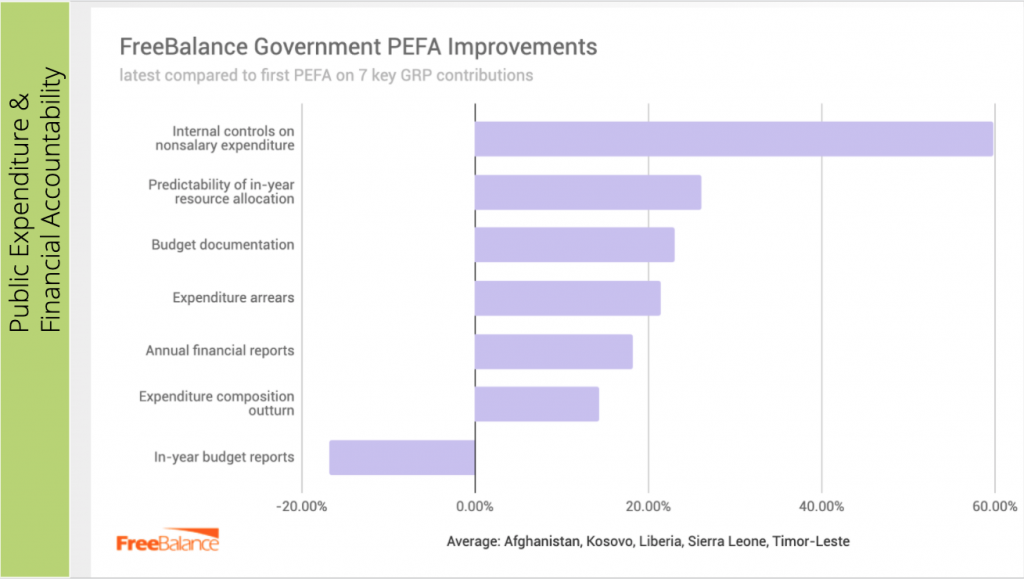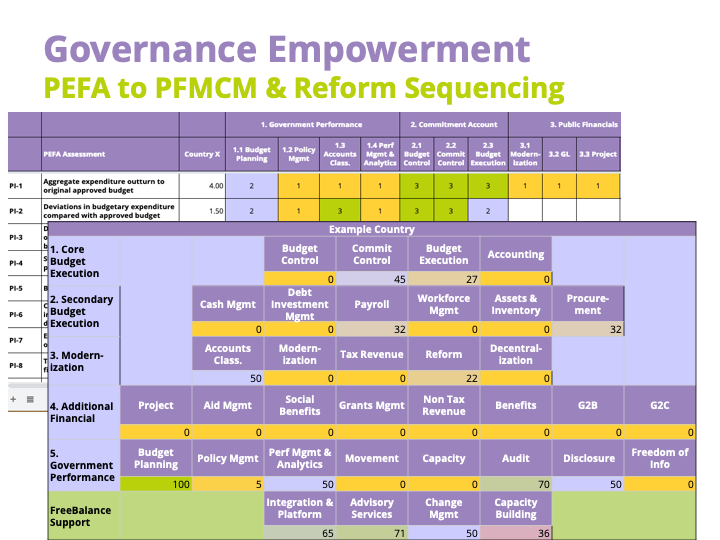Leverage the FreeBalance Accountability Suite and FreeBalance Advisory Service to Improve Public Financial Management
The big picture: reform achievements come via government will and persistence
- The configuration capabilities in our software help to PEFA scores by progressively activating more advanced procedures and policies
- It’s a question of leveraging good practices available in the software
- Any advice about improving PEFA scores should be focused on the country context
- Assessment improvement often means accepting lower scores in less important areas for governments while improving relatively good scores to support government priorities
What about PFM reform during a pandemic? That’s the subject of a recent PEFA Secretariat paper. And, a FreeBalance blog entry aligning recommendations from the IMF and World Bank
Context: contribution from FreeBalance products and services across PEFA pillars differs
- Some PEFA pillars benefit significantly from automation and process improvements
- Other PEFA pillars rely on formal procedures like audit and oversight more than automation and process
An alternative view is that PEFA assessments encourage governments to “look good” rather than “do good“
- There’s a danger of trying to “game the system”
- However, PEFA methods have improved, become more stringent, and can have the “PEFA check“
- We view PEFA as an opportunity to motive reform where improved ratings are a natural byproduct of public finance improvements

A January 2012 study showed how FreeBalance customers outperformed the average of latest PEFA assessments1, despite lower human capacity using the 2011 evaluation standard
- Higher than average Accounting, Recording, and Reporting than other countries despite a lower starting point by leveraging FreeBalance Accountability Suite functionality
- Higher than average External Scrutiny than other countries despite a lower starting point thanks to audit trails and improved budget communications leveraging the FreeBalance Accountability Suite
- Significant improvements in Comprehensiveness and Transparency by leveraging complete budget cycle views in the FreeBalance Accountability Suite
- Improved Predictability by leveraging controls and integration in the FreeBalance Accountability Suite
- Lower levels of policy-based budgeting as governments focused on improving budget execution

Takeaway: improvements in PEFA assessments, like the Timor-Leste quote used in the image, have been attributed to using built-in features of the FreeBalance Accountability Suite.
- Kosovo: “The internal control regime is comprehensive and highly relevant, with harmonization between legislation, secondary legislation and KFMIS application (including procedures and manuals that are developed and continuously modified). A new version of KFMIS was introduced by Treasury in 2014, key features being enhanced efficiency and greater user-friendliness and thus easier for staff to understand.” (KFMIS is the FreeBalance Accountability Suite)
- Liberia: “Performance improved due to greater use of IFMIS in compiling reports.” (IFMIS is the FreeBalance Accountability Suite)
- Mongolia: “Good progress has been made … in the functioning of the Treasury Single Account (TSA); and the expenditure limits exercised through the Government Financial Management Information System (GFMIS, Mongolia’s treasury system)” (GFMIS is the FreeBalance Accountability Suite)
- Sierra Leone: “The Accountant General has an Integrated Financial Management Information System (IFMIS), operating on a FreeBalance platform, which enables all commitments and payments to be made centrally on certified requests from Vote Controllers, and is the basis of budgetary control.” (IFMIS is the FreeBalance Accountability Suite)
Note: this is not press release spin about how a government expects improvement, this is the real thing – actual outcomes
We look forward to the next PEFA assessment from the Government of the Philippines after the implementation of the FreeBalance Accountability Suite, known as BTMS, “modern, integrated, accurate, reliable and secure information system“. The PEFA Secretariat concluded that the Government of the Philippines reforms and the adoption of BTMS: “In addition to re-introducing draft PFM reform legislation, the government sought to improve budget and procurement planning, and cash management, essential to moving from obligation- to cash-based budgeting, and implementing the Budget and Treasury Management System as the initial phase of the GIFMIS. These reforms took a more strategic view of the PEFA findings as part of the evidence on what was needed for further reform.”
Fast forward to today: governments who use FreeBalance software have shown remarkable improvements in 6 of 7 dimensions common in the PEFA 2011 and 2016 frameworks where we help most
- Significant improvements in controls for nonsalary expenditures
- Improvement in predictability, budget documentation, expenditure arrears, annual reports, expenditure composition outturn
- But, reduction in quality and timeliness of in-year budget reports despite improvements in annual reports

How could ratings for in-year budget reports dropped? Explanations include:
- more stringent criteria by evaluators in order to achieve the “PEFA Check”
- slowness in publishing reports generated from the system (PI-28.2) drops the composite PI-28 mark even when scores for coverage (PI-28.1) and accuracy (PI-28.3) are good
- possible lack of timely reconciliation because of a lack of integration with some key non-FreeBalance subsystems
- higher perceived need for real-time information for decision-makers
- increased focus on meeting international standards for annual reports
Consider your recent PEFA assessment
- Conventional wisdom holds that the results are not prescriptive, and that “not one size fits” all
How does FreeBalance help governments based on a PEFA?
- We extend the analysis to include country context to determine which part of the assessment is more important using over 400 data sources
- We map the PEFA and country context data to PFM domains using the Public Financial Management Component Map, developed by FreeBalance in 2008
- We develop a “straw man” reform sequence based on typical patterns
- We leverage public servant and FreeBalance expert analysis to update the reform sequence based on country context and government capabilities
- We call this advisory service: Governance Empowerment

Background: this service recommends legal reform and government process reform. The service also provides a roadmap for “progressive activation”:
- Configuration updates to support reform and international standards
- Integration methods to improve automation
- Functional updates based on human capacity improvements
1 Ratings are converted to numbers with D=1, A=4
